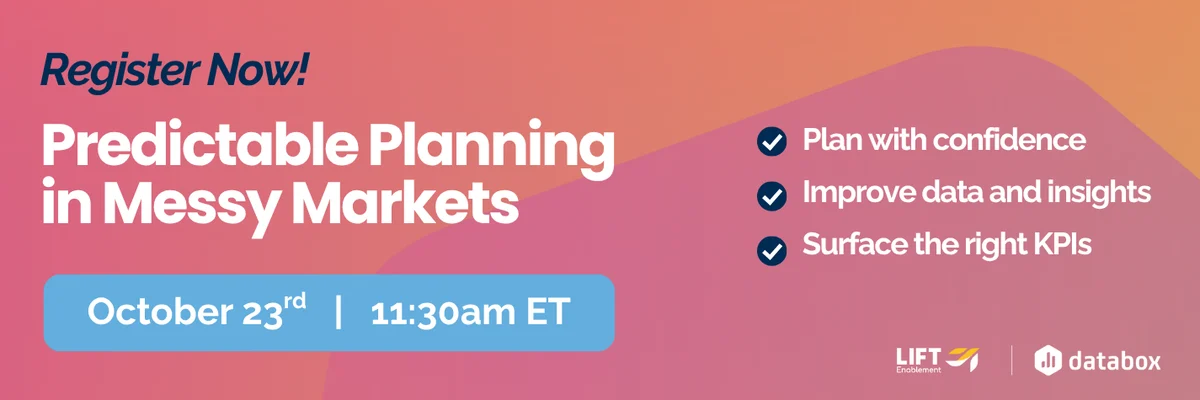When organizations reward outcomes rather than decision quality, they inadvertently punish smart risk-taking and reward lucky incompetence.
Business predictability—particularly revenue predictability—has emerged as the cornerstone of sustainable growth and competitive advantage. Research shows that 67% of revenue leaders identified improving revenue predictability as their #1 resolution, while organizations led by data-driven leaders are:
- 23x more likely to outperform competitors
- 9x more likely to retain customers,
- Up to 19x more profitable.
Predictability is not just advantageous; it is increasingly essential for survival and scaling.
Why Predictability is Business-Critical
The Foundation of Strategic Decision-Making
Predictability serves as the bedrock for virtually every business decision. Revenue forecasting drives company decisions around investments and spending, investor perceptions of the company, and even your ability to attract talent. Without reliable forecasts, companies operate in a constant state of reactive management rather than strategic planning.
Key Benefits of Predictable Revenue:
Financial Stability and Planning: Predictable revenue helps businesses reduce uncertainty in their sales efforts, improve scalability, and create sustainable growth. When organizations can forecast revenue with confidence, they gain the ability to:
-
- Budget accurately for operational expenses
- Plan strategic investments in technology and talent
- Maintain healthy cash flow management
- Secure favorable financing terms from investors and lenders
Operational Efficiency: An interconnected, fully visible revenue process supports the entire customer life cycle, enabling you to pinpoint and address any roadblocks throughout the process. Predictable systems enable:
-
- Optimized resource allocation across departments
- Streamlined hiring and capacity planning
- Efficient inventory and supply chain management
- Systematic process improvements
Investor Confidence and Valuation: From the perspective of a venture capitalist, predictable revenue is a key indicator of a company's viability and potential for return on investment. Companies with predictable revenue streams command higher valuations and attract better terms during fundraising or acquisition discussions.
Competitive Advantage Through Scalability: A structured sales system makes it easier to scale operations as the company grows. Predictable revenue models provide the foundation for sustainable expansion without proportional increases in costs or complexity.
The Psychology of Predictability
Beyond the financial metrics, predictability provides psychological benefits that cascade throughout the organization. An additional benefit, one not to be taken lightly, is peace of mind, freeing leaders from the overwhelming anxiety caused by fluctuating sales and unpredictable cash flows. This stability enables leadership teams to focus on strategic growth initiatives rather than firefighting operational crises.
Every Decision is a Bet on an Uncertain Future
The Fundamental Nature of Business Decisions
At its core, every business decision, from hiring an employee to entering a new market, pricing a product, or allocating capital, is fundamentally a bet on an unknowable future. This isn't hyperbole or metaphor; it's the literal reality of decision-making under uncertainty.
Professional poker player and decision strategist Annie Duke captures this perfectly: "Treating decisions as bets, I discovered, helped me avoid common decision traps, learn from results in a more rational way, and keep emotions out of the process as much as possible." The insight here is profound: whether you're betting chips at a poker table or betting your company's resources on a strategic initiative, you're engaging in the same fundamental act, committing resources to a single outcome among many possible futures.
Understanding the Components of Every Bet
When we frame decisions as bets, we recognize that there are precisely two things that determine how our lives and businesses turn out: the quality of our decisions and luck. This reframing forces us to acknowledge several uncomfortable truths:
Incomplete Information is the Rule, Not the Exception: Leaders constantly make decisions in the absence of complete information, and often underappreciate how random and uncertain the world is. The reality is that leadership requires constant judgment in uncertain situations. Even the best decision doesn't yield the best outcome every time. There's always an element of luck that you can't control, and there is always information that is hidden from view.
The Resulting Trap: One of the most dangerous cognitive biases in business is what poker players call "resulting" - judging the quality of a decision based purely on its outcome. Leaders may reward good outcomes rather than good decisions, and punish bad outcomes rather than bad decisions. Many managers fail to distinguish between good and bad decisions because they are so focused on outcomes. Read that again for good measure.
This creates a cascading problem: when organizations reward outcomes rather than decision quality, they inadvertently punish smart risk-taking and reward lucky incompetence. A team that makes a brilliant strategic bet that fails due to unforeseen circumstances gets blamed, while a team that makes a poor decision that succeeds through luck gets celebrated. Over time, this destroys organizational learning and decision-making capacity.
The Probability Distribution of Futures: When you make any business decision, you're not choosing between success and failure—you're choosing between different probability distributions of possible outcomes. Hiring a candidate isn't a binary bet on whether they'll be good or bad; it's a bet on a range of possible performance outcomes, each with different probabilities and different impacts on your organization.
This probabilistic thinking is a far better way to make decisions and view the world than relying on our default, primordial cognitive biases. By moving away from needing to be 100% sure, and getting comfortable with saying "I don't know," you unlock more nuanced thinking while also encouraging the contributions of others.
Why Predictability Reduces the Stakes of Each Individual Bet
Here's where predictability becomes transformative: when you build systems that generate predictable outcomes, you're not eliminating the betting nature of decisions—you're changing the odds and reducing the variance.
Portfolio Theory Applied to Decisions: Professional gamblers acknowledge that their success is due in some part to the cards they are dealt. Predictable business systems allow you to make many smaller bets rather than a few large ones, diversifying your risk across a portfolio of decisions.
A company with predictable revenue can afford to make strategic investments that might fail. A company without predictability must make every decision a survival bet, which paradoxically increases the chance of catastrophic failure.
Decision Velocity and Learning Loops: When outcomes are predictable, you can establish what Duke calls an "ideal learning loop," a systematic process of making decisions based on beliefs, observing outcomes, and updating beliefs based on what you learn. But this only works when you can distinguish between skill and luck in the outcomes.
Unpredictable environments make learning nearly impossible because you can't tell if a bad outcome resulted from a poor decision or just bad luck, and you can't tell if a good outcome resulted from skill or fortune.
The Strategic Implications for Business Leaders
Acknowledging Uncertainty as Strategy: Uncertainty is an uncomfortable position. But certainty is an absurd one. The first step in better decision-making is acknowledging that uncertainty is always higher than you think. In stressful times, our biological hardwiring sends us into "fight or flight mode." To counteract this natural stress response, the best thing to do, literally, is pause and take a breath. While taking a moment to step back and give yourself time to make a decision may feel counterintuitive, making decisions from a state of stress can be a tragic mistake.
Different Levels of Uncertainty Require Different Strategies: Research shows that uncertainty exists at different levels, each requiring different strategic approaches:
-
- Level 1: A clear enough future with predictable outcomes
- Level 2: Alternate futures with a discrete set of possible outcomes
- Level 3: A range of futures along a continuum
- Level 4: True ambiguity where we cannot predict what might happen
- Level 1: A clear enough future with predictable outcomes
Mid-market companies often face Level 2 and Level 3 uncertainty in their markets. Predictability systems help move decisions toward Level 1 wherever possible, preserving resources for the necessary Level 3 and 4 bets.
The Paradox of Prediction: We're terrible at predicting the future, yet we must make decisions as if we can. The solution isn't to pretend we can see the future more clearly, it's to build systems that work across a range of possible futures. This is the essence of predictable revenue models: they don't predict the future perfectly; they reduce your dependency on any single prediction being correct.
Practical Applications for Mid-Market Companies
Scenario Planning as Bet Hedging: Instead of betting everything on one forecast, develop multiple scenarios representing different possible futures. Then build strategies that work reasonably well across all scenarios—these are "no-regrets moves" that will pay off no matter what happens. Managers often focus on obvious no-regrets moves such as reducing costs, gathering competitive intelligence, or building skills. However, even in highly uncertain environments, strategic decisions such as investing in capacity and entering certain markets can be no-regrets moves.
Options and Reversibility: Structure decisions to create options rather than commitments wherever possible. Options are designed to secure the big payoffs of the best-case scenarios while minimizing losses in the worst-case ones; classic examples include conducting pilot trials before the full-scale introduction of a new product, entering into limited joint ventures for distribution to minimize the risk of breaking into new markets.
Measuring Decision Quality, Not Just Outcomes: Build systems that evaluate whether the decision-making process was sound, regardless of outcome. Did you consider the right alternatives? Did you have the right information? Were the probabilities properly assessed? Did you account for your own cognitive biases?
This shift from outcome-focused to process-focused evaluation fundamentally changes an organization's culture. It encourages smart risk-taking, honest reporting of problems, and continuous learning—all essential for building predictable systems.
The Meta-Bet: Investing in Predictability
Perhaps the most important insight is this: investing in predictability systems is itself a bet—a meta-bet on your ability to make better bets in the future. When you build RevOps infrastructure, implement CRM systems, develop forecasting capabilities, and establish data-driven processes, you're betting that these investments will improve your decision-making capacity.
The research strongly supports this bet: Organizations led by data-driven leaders are 23 times more likely to outperform competitors. Companies with clearly defined strategies outperform peers by up to 3x in revenue growth. But the underlying reason isn't magic—it's that these systems reduce the variance in outcomes, allowing for better learning, faster iteration, and more confident future bets. Predictability in business operations, particularly revenue generation, represents the difference between sustainable success and eventual failure. With 82% of businesses failing due to cash flow problems and companies with clearly defined strategies outperforming peers by up to 3x in revenue growth, the imperative for mid-market companies to build predictable go-to-market engines has never been clearer.
However, understanding predictability requires grasping a deeper truth: every business decision is fundamentally a bet on an uncertain future. We're not trying to eliminate uncertainty or perfectly predict outcomes—that's impossible. Instead, we're building systems that reduce variance, enable learning, and allow us to make more bets with better odds.
The path forward requires a systematic approach combining strategic thinking, operational excellence, and technological enablement. By implementing the frameworks and strategies outlined in this analysis, mid-market companies can transform their operations from reactive and unpredictable to strategic and scalable, positioning them for long-term success.
The investment in predictability pays dividends not only in financial performance but in organizational stability, employee satisfaction, customer relationships, and market position. In an increasingly competitive business environment, predictability isn't just an advantage; it's essential for survival and growth.

 Doug Davidoff
Doug Davidoff